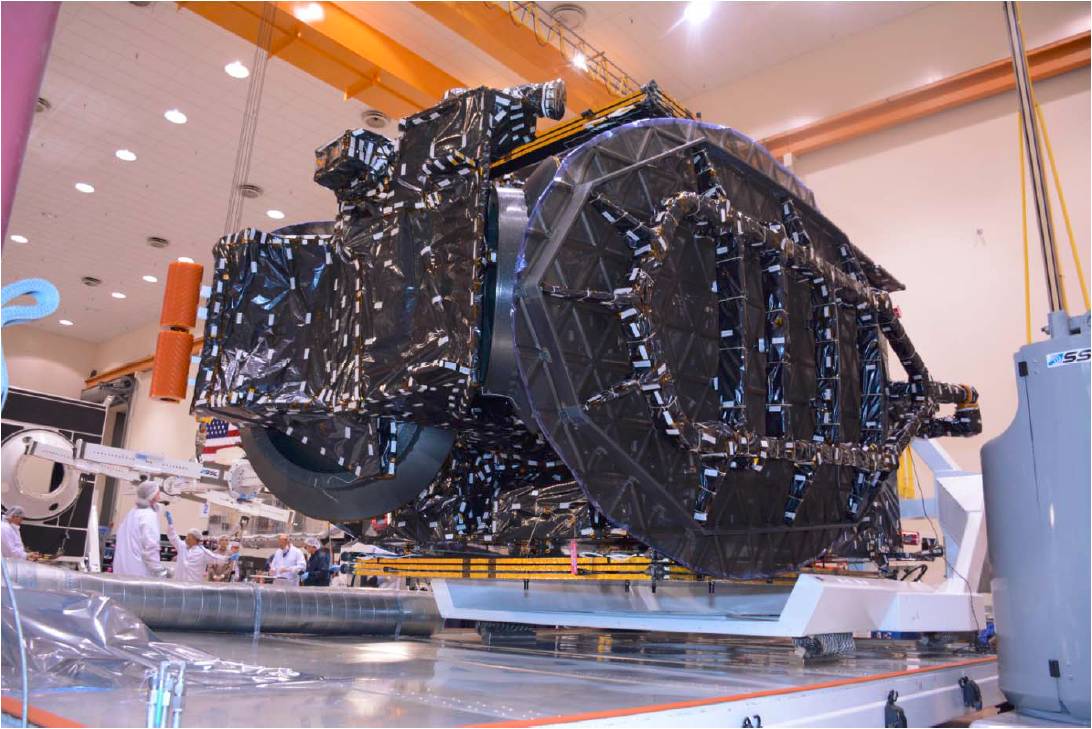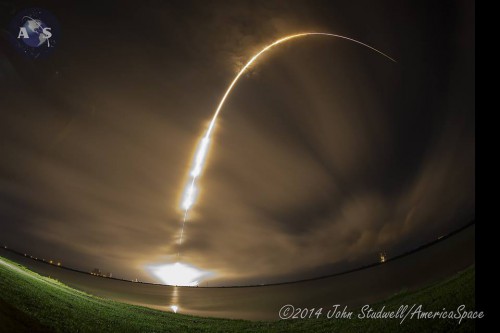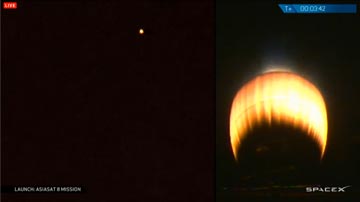
Three weeks after launching the AsiaSat-8 communications satellite, SpaceX is primed to deliver its sibling, AsiaSat-6, into geostationary transfer orbit at an altitude of 22,236 miles (35,786 km) on Wednesday, 27 August. The Hawthorne, Calif.-based launch services organization—headed by entrepreneur Elon Musk—will launch its fifth Falcon 9 v1.1 rocket of 2014 during a three-hour “window,” which extends from 12:50 a.m. until 4:05 a.m. EDT. As with AsiaSat-8, the geostationary altitude of this heavyweight mission requires the maximum performance capability of the Falcon 9 v1.1, and consequently the booster will not be equipped with extendible landing legs and will not perform a “propulsive return-over-water” and controlled splashdown.
In spite of a frustrating summer, which saw the Orbcomm OG-2 mission delayed repeatedly, prior to a successful launch on 13 July, SpaceX picked itself up and scored two “personal bests” with AsiaSat-8, delivering two payloads within three weeks of each other and accomplishing a record fourth flight in a single calendar year. This achievement followed on the heels of two earlier successes in 2014: the delivery of the Thaicom-6 satellite into geostationary transfer orbit in January and the launch of the third dedicated Dragon cargo mission (SpX-3) toward the International Space Station (ISS) in April, fulfilling part of SpaceX’s $1.6 billion Commercial Resupply Services (CRS) contract with NASA.
Originally aiming for an opening launch attempt on Tuesday, 26 August, within a three-hour “window” from 12:50 a.m. until 4:05 a.m. EDT, SpaceX opted to postpone the AsiaSat-6 mission by 24 hours, pending Air Force Range approval, following last Friday’s failure and explosion of the Falcon 9 Reusable Development Vehicle (F9R Dev). “While Friday’s F9R three-engine, single-stage test article and our launch site in McGregor, Texas, are very different from the planned Cape Canaveral, Fla., launch of the AsiaSat-6 satellite on the Falcon 9 rocket,” SpaceX reported in a statement released early Sunday, 24 August, “we are taking some additional time to review the circumstances that caused the test vehicle to auto-terminate to confirm that there is not a risk to orbital flight. Pending final Air Force approval of this request, the AsiaSat-6 mission is now targeted to launch at 12:50 a.m. EDT Wednesday, with a backup launch window on Thursday.”
Perhaps harking back to its ill-judged media blackout and “routine” assertion made about the nature of rocket launches, back in June, SpaceX’s press kit for the AsiaSat-6 mission noted that “All spaceflight is inherently complicated,” adding that “every component of the mission must operate optimally” and highlighting that “if any aspect of the mission is not successful, SpaceX will learn from the experience and try again.”
The two-stage Falcon 9 v1.1 rocket for the AsiaSat-6 mission—which will be making its seventh total flight in less than 11 months—was transferred to Space Launch Complex (SLC)-40 at Cape Canaveral Air Force Station, Fla., on Friday, 22 August, minus its payload fairing, to support a static test-firing of the nine Merlin-1D first stage engines. Upon successful completion of this standard pre-launch protocol on Friday, the vehicle was returned to a horizontal configuration and taken back to the integration building, where AsiaSat-6 and its bulbous payload fairing were installed. The complete stack will then be rolled out to SLC-40, ahead of the launch attempt at 12:50 a.m. EDT Wednesday. The expansive launch window runs for three hours and 15 minutes, and past experience indicates that SpaceX will likely utilize its entire span, if needed.

With weather conditions for the small hours of Wednesday morning forecasted by Patrick Air Force Base meteorologists as cloudy, with a 50 percent likelihood of rain and a 20 percent probability of lightning, the process of fueling the Falcon 9 v1.1 with liquid oxygen and a highly refined form of rocket-grade kerosene (known as “RP-1”) will get underway late Tuesday evening. The cryogenic nature of the oxygen—whose liquid state exists within a temperature range from -221.54 degrees Celsius (-368.77 degrees Fahrenheit) to -182.96 degrees Celsius (-297.33 degrees Fahrenheit)—requires the fuel lines of the Merlin-1D engines to be chilled down, in order to avoid thermally shocking and fracturing them. Within an hour, all propellants should be fully loaded.
At 12:37 a.m. EDT Wednesday, the countdown will reach its final “Go-No Go” polling point of all stations at T-13 minutes. Assuming that the Falcon 9 v1.1, its payload, and all supporting facilities pass smoothly through the polls, the terminal countdown will get underway at T-10 minutes. During this phase, the Merlin-1D engines will be chilled, ready for their ignition sequence, and at 12:43 a.m. AsiaSat-6 will be transferred to internal power and the rocket itself will transition to its on-board batteries. All external power utilities from the Ground Support Equipment (GSE) will be disconnected, and at 12:45 a.m. the approximately 90-second process of retracting the “strongback” away from the vehicle will get underway. The Flight Termination System (FTS)—tasked with destroying the rocket in the event of a major accident during ascent—will be placed onto internal power and armed.
By T-2 minutes and 15 seconds, the first stage tanks will reach flight pressure. The Merlin-1D engines will then be purged with gaseous nitrogen, and, at T-60 seconds, SLC-40’s “Niagara” deluge system of 53 nozzles will be activated, flooding the pad surface and flame trench with 30,000 gallons (113,500 liters) of water, per minute, to suppress acoustic waves radiating from the engine exhausts. At T-3 seconds, the nine engines will roar to life, ramping up to a combined thrust of 1.3 million pounds (590,000 kg). Following computer-commanded health checks, the Falcon 9 v1.1 will be released from SLC-40 to commence SpaceX’s fifth mission of 2014, turning night into day across the marshy Florida landscape.
Immediately after clearing the SLC-40 tower, the rocket will execute a combined pitch, roll, and yaw program maneuver to establish itself onto the proper flight azimuth to inject AsiaSat-6 into geostationary transfer orbit. Eighty seconds into the ascent, the vehicle will exceed the speed of sound and experience a period of maximum aerodynamic stress (colloquially known as “Max Q”) upon its airframe. At about the same time, the Merlin-1D Vacuum engine of the second stage will undergo its own chill-down process, preparatory to its own ignition later in the ascent phase. At 12:52 a.m., 130 seconds after liftoff, two of the first-stage engines will throttle back, under computer control, in order to reduce the rate of acceleration at the point of Main Engine Cutoff (MECO).

Finally, at 12:52:41 a.m., the seven remaining first-stage engines will shut down and the lower component of the Falcon 9 v1.1 will separate from the rapidly ascending stack. The turn will then come for the restartable second stage, whose single Merlin-1D Vacuum engine—with a maximum thrust of 180,000 pounds (81,600 kg)—will roar to life at 12:52:49 a.m. to continue the boost to deliver AsiaSat-6 into orbit. Thirty seconds into its burn, the 43-foot-tall (13.1-meter) payload fairing will be jettisoned, exposing the satellite to the space environment for the first time. Finally, the Merlin-1D Vacuum will shut down at 1:09:35 a.m., after which the stack will coast for 17 minutes, prior to a restart at 1:26 a.m. AsiaSat-6 will be released from the second stage into free flight a few minutes later at 1:32 a.m.
Built by Space Systems/Loral (SS/L), the cube-shaped satellite weighs 8,100 pounds (3,700 kg) and represents one of the largest and most powerful AsiaSats ever inserted into orbit. Following initial checkout, AsiaSat-6 will be positioned at 120 degrees East longitude. It will be operated by the Asia Satellite Telecommunications Company Ltd., founded in 1988 and headquartered in Hong Kong. Fourteen of its 28 high-powered C-band transponders will be leased to Thaicom—under a $171 million, 15-year contract, signed in December 2011—who will market them as “Thaicom-7.” The satellite is equipped with one “global” beam and one “regional” beam, providing region-wide coverage of Asia, Australasia, Central Asia, and the Pacific Islands, with enhanced power and look angles over Pacific Rim countries.
AsiaSat selected SS/L in November 2011 to build its AsiaSat-8 and AsiaSat-6 platforms, both of which are expected to support 15-year operational lifetimes. Based upon the LS-1300 “bus,” with a pair of deployable solar arrays and batteries, both satellites breezed through thermal vacuum tests last December and underwent dynamic tests and Compact Antenna Test Range (CATR) tests in January-February 2014. The latter allowed engineers to measure antenna and payload performance and demonstrate their compliance with spacecraft specifications. “These critical tests are essential,” AsiaSat reported in December 2013, “in order to achieve the highest quality and reliability of the spacecraft before shipment to the SpaceX launch pad at Cape Canaveral.”
AsiaSat-6 was delivered to the Cape on 31 July to begin final processing ahead of its Falcon 9 v1.1 launch. Following extensive tests, the satellite was last week encapsulated within its bulbous payload fairing. The size and mass of the satellite demands a 17.1-foot-diameter (5.2-meter) fairing, which stands about 43 feet (13.1 meters) tall.
The arrival of AsiaSat-6 will mark the 10th in a series of satellites, which can trace its ancestry back almost a quarter-century. AsiaSat-1, launched atop a Chinese Long March-3 booster in April 1990, had an interesting back story, for it was originally the Westar VI communications satellite, delivered into an improper orbit by shuttle mission 41B in February 1984 and triumphantly retrieved and returned to Earth by the 51A crew the following November. AsiaSat-2 followed in November 1995, also aboard a Long March rocket, after which the third (AsiaSat-3) and fourth (AsiaSat-3S) satellites in the series were delivered by Russian Proton-K boosters in December 1997 and March 1999. The latter replaced the decomissioned AsiaSat-1 from May 1999 and is today the oldest member of the fleet still in operational status. Kicking off the 21st century, AsiaSat-4 rode an Atlas IIIB from Cape Canaveral in April 2003, followed by AsiaSat-5 atop a Proton-M/Briz-M from Baikonur in August 2009, AsiaSat-7 in November 2011, and AsiaSat-8 in August 2014.
AsiaSat-5 entered the headlines in the summer of 2014, during the World Cup coverage from Brazil, when it delivered the first-ever live telecast of the international football competition in 4K resolution. Commonly (though not strictly accurately) known to the general consumer as “ultra-high-definition television” (UHDTV), 4K produces horizontal resolution of close to 4,000 pixels and more than four times higher-than-standard HDTV, and is capable of 60 frames per second. AsiaSat-5 delivered live 4K coverage of the Colombia-Uruguay Round of 16 match on 28 June, followed by the Germany-France quarter-final on 4 July, and the final, between Germany and Argentina, on 13 July. According to AsiaSat, the worldwide number of 4K television households is expected to rise from 2.2 million at the end of 2013 to as high as 66.2 million by the end of 2018. Moreover, the Asia-Pacific region is expected to become the single largest 4K television market by 2016, accounting for 42 percent of global 4K television households.
Want to keep up-to-date with all things space? Be sure to “Like” AmericaSpace on Facebook and follow us on Twitter: @AmericaSpace
Missions » Commercial Space » AsiaSat » AsiaSat-6 »




GO SPACEX!
SpaceX has now delayed the launch by one to two weeks.
So that will then push CRS 4 back as well and I heard that they will NOT be landing on a sea barge with the first stage with CRS 4…How disappointing…
Tracy,
A delay in CRS-4 is certainly possible.
About the landing on a barge at sea, that would require a precision in lateral alignment not yet demonstrated by SpaceX in either there actual launches or the flight demonstrators. It would also require use of more fuel that would add further weight to the F9 first stage and thus further reduce the vehicles payload capability.
Also required would be an modified barge – which (at least as far as I know)they have yet to unveil
So I guess that will be another “Ka-Boom” moment as Elon likes to call them…
If the vehicle misses its (relatively small) target, it would more likely be “Ka-Splash” moment, but the more important point (making the assumption that all these maneuvers will eventually be practical) is the reduction in vehicle payload capacity.
SpaceX is already not performing “re-usability” tests on some flights because even that reduces payload too much.
– How much further will payload be reduced to attempt a precision landing?
– How much to do a retrograde maneuver (to return the vehicle to the launch site)?
– How useful will the vehicle (at that point) be?
Hi Tracy,
SpaceX has said since day 1 that Falcon flight 13 for CRS4 would be another splash landing, I’m not sure why so many assume otherwise, the company is aiming for landing on a solid surface for Falcon flights 14 & 15, with the first possible true land landing on the following test.
See story – http://www.americaspace.com/?p=64550
By the way, we will have a story specifically on the company’s upcoming soft landing tests soon, as we are currently working with SpaceX to gather the information & comments needed to produce a detailed report.
Musk told CNN’s Rachel Crane in an interview conducted Aug. 21 at SpaceX. “I did have for a while these sort of horrible nightmares of rockets failing before launch because in the very beginning our rockets did not succeed.”
This is really sharing way to much!!!
http://www.webpronews.com/spacexs-grasshopper-rocket-now-moves-sideways-and-its-incredible-video-2013-08
“On August 13th, the Falcon 9 test rig (code name Grasshopper) completed a divert test, flying to a 250m altitude with a 100m lateral maneuver before returning to the center of the pad. The test demonstrated the vehicle’s ability to perform more aggressive steering maneuvers than have been attempted in previous flights.
Grasshopper is taller than a ten story building, which makes the control problem particularly challenging. Diverts like this are an important part of the trajectory in order to land the rocket precisely back at the launch site after reentering from space at hypersonic velocity.”
http://www.youtube.com/watch?feature=player_embedded&v=2t15vP1PyoA
Joe why do you keep saying that SpaceX has never flown a grasshopper test vehicle sideways?